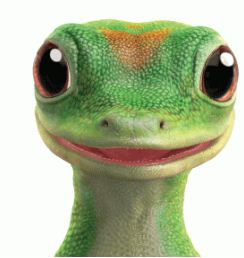SLP Corner: Beyond the Geico Gecko: The Use of Advertising in Therapy with Adolescents

Image Credit: Geiko.com
by: Karen Clark, M.A. CCC-SLP
When developing lessons that target specific language skills in adolescents, the use of high interest and relevant material engages students and provides an opportunity for students to learn and generalize concepts. Advertising is a medium that gives us a wealth of creativity, imagination, and ambiguity and is a perfect resource for the therapy or classroom setting. Using print ads, vintage ads, and commercials in therapy affords the opportunity to target a multitude of language and critical thinking skills. Even articulation, fluency, and verbal/written expression skills can easily be integrated into a lesson with this form of media.
Listed below are suggested genres of advertising that can be utilized in therapy:
1. Print Ads: Print Ads are the advertisements typically viewed in magazines. Modern ads have evolved into a unique art form and often provide us with a puzzle to solve when analyzing pictured representations of products. Advertisers frequently display the product label or name in the corner of an ad and the related picture in the ad is meant to capture the attention of the consumer. However, the correlation between the pictured representation and the product is not always obvious to our students and can be difficult to decipher. This contrast provides a wealth of opportunities in order to address literary concepts (e.g. hyperbole, personification), parts of speech, reasoning skills, analogies, etc. The creativity of the ads often spark discussion and students enjoy the challenge of trying to decipher the advertiser’s intent within the ad.
2. Vintage Ads: Older ads are a wonderful way to illustrate social norms, societal trends, and stereotypes. Discussion using this genre of ads gives us the opportunity to promote discussion and target a variety of language skills (e.g. reasoning, compare/contrast, pragmatics, main idea, inferential thinking, etc.).
3. Zoo Ads: Many zoos have developed highly creative campaigns to promote exhibits and events. These ads tie in beautifully to lessons that address the literary concepts of personification and hyperbole as well as the other language concepts listed above.
4. Commercials: Commercials have evolved over the years into a unique art form and are now highly anticipated during events such as the Super Bowl. Commercials that are “school appropriate” are accessible through company websites (e.g. Geico, Volkswagen) as well as through the site, YouTube. Depending on the theme of the commercial, targeted skills in therapy can include a multitude of concepts including analogies, metaphors, idioms, sequencing, problem solving, compare/contrast, inferences, etc.
In today’s society, advertising is a highly influential medium that impacts trends and consumerism. Using this creative resource in therapy provides a multitude of opportunities for discussion and analysis. Additionally, building an awareness of media strategies serves to further enhance independent living skills in our older students. Who knew advertising could do so much???
Featured Author/Organization: Karen Clark, M.A., CCC-SLP and SpeechDrive.net
About Karen: Karen is a Speech/Language Pathologist in Glendale, Arizona who presently works in both the public school setting with adolescents and within a skilled nursing facility. Karen’s website, www.speechdrive.net, provides free therapy activities for use with adolescents and upper elementary grades as well as with adults.
PediaStaff is Hiring!
All JobsPediaStaff hires pediatric and school-based professionals nationwide for contract assignments of 2 to 12 months. We also help clinics, hospitals, schools, and home health agencies to find and hire these professionals directly. We work with Speech-Language Pathologists, Occupational and Physical Therapists, School Psychologists, and others in pediatric therapy and education.
